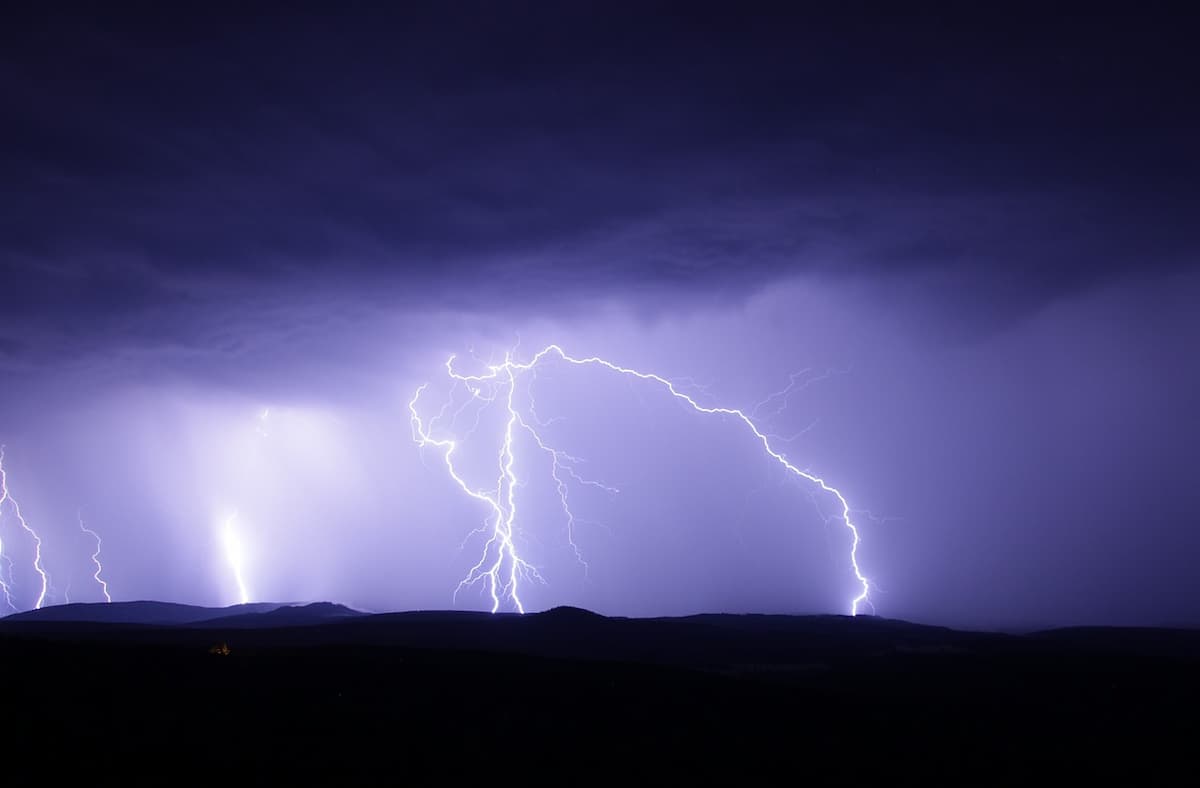Everyone gets startled by thunder, and dogs are no exception.
Picture this: a sunny day suddenly turns dark as clouds roll in.
The once calm atmosphere is shattered by a deafening crack of thunder.
As you run to find shelter, you notice your furry friend cowering in fear, seeking solace under your bed.
Ever wondered why are dogs become terrified by thunder? Read on to learn more.
The science behind dogs’ fear of thunder: Insights into their acute hearing and sensory perception
Dogs possess a much wider range of hearing than humans, allowing them to pick up on sounds that are inaudible to our ears.
They can even detect high-frequency sounds 4 times farther than humans, which means they experience thunder at a much greater intensity.
Thus, the low-frequency rumble of thunder can be particularly distressing for them.
Imagine a sudden rumbling that reverberates through your entire body – that’s what it feels like for dogs, except their experience is even more intense.
With their superior auditory acuity, they can hear thunder from miles away, well before we even notice a storm brewing on the horizon.
But it’s not just their sharp ears that make them scared; their remarkable sensory perception also plays a significant role.
Dogs are highly attuned to their environment, capable of sensing subtle changes in atmospheric pressure, static electricity, and electromagnetic fields.
During a thunderstorm, these natural phenomena go awry, creating an atmosphere that feels strange and unsettling to our canine friends.
The build-up of static electricity and changes in electromagnetic energy can be alarming, triggering feelings of anxiety and fear in dogs.
So, when the thunder finally rolls in, it’s no wonder they seek shelter and companionship, desperately looking for comfort and security in the presence of their loved ones or a cozy hiding spot.
Understanding the impact of fear on dogs during thunderstorms: Signs to watch out for
It’s a dark and stormy night, and you notice your furry friend pacing restlessly around the house, whining, and seeking refuge under the furniture.
Here are some fearful behaviors to watch out for when a thunderstorm comes rolling in:
- Trembling or shaking uncontrollably;
- Pacing or restlessness;
- Excessive panting or drooling;
- Hiding under furniture or in small spaces;
- Destructive behavior, like chewing or scratching;
How Can We Help Our Fur Babies? Practical strategies to help calm your scared dog during thunderstorms
When dark clouds form and the sound of thunder rumbles through the sky, many dogs become filled with fear and anxiety.
It’s a common sight to see our furry companions cowering under tables or seeking refuge in closets during thunderstorms.
But have you ever wondered why dogs get so scared of thunder? Let’s explore this fascinating topic and discover some practical strategies that can help calm your scared dog during thunderstorms.
- Create a safe haven: One effective way to alleviate your dog’s fear during thunderstorms is to create a safe haven where they can feel secure.
Choose a quiet room in your house, preferably one without windows or with windows covered by curtains.
Provide your furry friend with their favorite bed, toys, and blankets to create a cozy and comforting space.
This area can act as their personal refuge whenever a thunderstorm hits, helping to minimize their anxiety.
- Distract with calming sounds and scents: During thunderstorms, distracting your dog’s attention from the loud noises can make a world of difference.
Play calming music or white noise in the background to help drown out the sound of thunder.
Additionally, using pheromone diffusers or sprays can emit calming scents that can help relax your dog.
Pheromone diffusers, such as Adaptil, release synthetic pheromones that mimic the calming scents produced by nursing mother dogs.
These products can help reduce anxiety and create a sense of security for your pup.
Additionally, natural remedies like chamomile or lavender can be used in diffusers to promote relaxation.
- Behavior modification techniques: Behavior modification techniques can play a crucial role in helping your dog manage their fear of thunderstorms.
Gradual desensitization is a popular technique where you expose your dog to the sound of thunder at a volume that they can tolerate and slowly increase it over time.
Pairing this exposure with positive experiences, such as treats or playtime, can help rewire their fearful response.
Another technique is counterconditioning, where you redirect your dog’s focus from the thunder by engaging them in activities they enjoy, such as training or playing with interactive toys.
By understanding why dogs get so scared of thunder and implementing practical strategies like creating a safe haven, using calming sounds and scents, and utilizing behavior modification techniques, you can help your furry friend find peace during thunderstorms.
Remember, each dog is unique, so it may take time and patience to find the methods that work best for your beloved pet.
Stay calm, be understanding, and provide the comfort they need to weather the storm with confidence.
FAQ
Q: What is it about thunder that causes dogs to become scared? A: It’s a combination of factors.
Firstly, the loud noise thunder produces can be incredibly intense for dogs whose senses are much more acute than ours.
Thunder can be like an explosion right next to their ears!
Plus, dogs have a natural instinct to be cautious around sudden loud sounds, which goes way back to their wild ancestors who needed to stay alert to survive.
Q: How do dogs perceive thunder compared to humans?
A: Well, humans can perceive thunder as an exciting spectacle or just a part of nature’s symphony.
However, dogs hear the low-frequency rumbling that we often miss, and it can sound like the end of the world to them!
For them, a loud thunderclap might even feel like a threat approaching, which can trigger their fight-or-flight response.
Q: Can dogs sense the changes in atmospheric pressure associated with thunderstorms?
A: Absolutely! Dogs can sense changes in atmospheric pressure, which may occur right before a storm.
This sensitivity can further intensify their anxiety because they experience these invisible shifts and can’t quite understand the cause.
It’s like they know something big is about to happen but can’t comprehend what it is.
Q: Why do some dogs try to hide or seek comfort during a thunderstorm?
A: Dogs seek comfort during thunderstorms in the same way some humans may seek the solace of a loved one during a scary movie.
They perceive storms as a threat, and hiding or seeking shelter close to their human or a safe space gives them a sense of security. Being near us helps them feel protected and reassured that everything will be okay.
Q: How can we help our furry friends when they’re scared of storms? A: There are a few strategies we can employ.
One method is to create a safe space where they can retreat to during a storm, such as a cozy corner with their bedding or a crate covered with a blanket.
Calming music or a white noise machine can also help mask the sound of thunder.
Moreover, it’s essential to stay calm ourselves and avoid rewarding their fearful behavior, as it could inadvertently reinforce their fear.
Q: Are there any long-term solutions to help dogs cope with their fear of thunderstorms?
A: Absolutely!
Consult your veterinarian or a professional trainer who can offer techniques like desensitization or counterconditioning.
These methods involve gradually exposing your dog to the sounds of thunder while providing positive experiences, like treats or playtime, to change their emotional response.
Q: Should I be concerned if my dog’s fear of thunderstorms worsens over time?
A: It’s always essential to be attentive to any significant changes in your dog’s behavior.
If their fear of thunderstorms becomes increasingly distressing or begins to impact their daily life, it’s wise to seek advice from a veterinarian or a qualified animal behaviorist.
They can provide guidance on anxiety management techniques or recommend other solutions to ensure the well-being and happiness of your four-legged companion.
Q: Is it common for dogs to outgrow their fear of thunderstorms?
A: While some dogs may show improvement over time as they learn to cope with storms, it’s crucial to understand that fears can be deeply ingrained.
With proper intervention and support, many dogs can learn to manage their anxiety better, but it’s rare for them to completely outgrow their fear.
Remember, our love and understanding can make a world of difference in helping them navigate these stormy situations.
Closing Remarks
And that is why dogs are terrified of thunder.
It turns out, these furry companions of ours have some pretty justified fears when it comes to those booming sounds from the sky.
Imagine being in their paws for a moment - the sight of lightning flashing across the dark sky, followed by a loud clap of thunder that shakes their sensitive ears.
It’s enough to make anyone jump!
But the truly fascinating part is the unique combination of factors that contribute to their fear.
From their acute sense of hearing to their instinctual response as den animals, dogs are wired to feel anxious when it storms.
Their hearing is a thousand times more sensitive than ours, picking up even the faintest of sounds.
So, when thunder rumbles in the distance, it’s like an explosion going off right next to them.
No wonder they run for cover!
Then we have their instincts as den animals.
You see, dogs seek out small, enclosed spaces when they feel threatened.
It makes them feel safe and secure, just like hiding in a cave or a burrow.
So during a thunderstorm, you’ll often find your pup trying to squeeze themselves into the tightest nooks and crannies they can find – under the bed, behind the couch, or even in your laundry basket!
But don’t worry, dear readers, for we can help our furry friends overcome their fear.
First off, try creating a safe space for them, like a cozy blanket-covered crate or a designated corner with a soft bed.
This will give them a sense of security when those terrifying sounds kick in.
You can also try playing soothing music or white noise to drown out the thunderous booms.
Some dogs find comfort in the sound of classical music or specially designed dog relaxation tracks. Anything to distract them from the terrifying noises outside!
Lastly, remember to be a calming presence for your pup during these storms.
They look to us for guidance and reassurance, so try to maintain a calm and relaxed demeanor.












